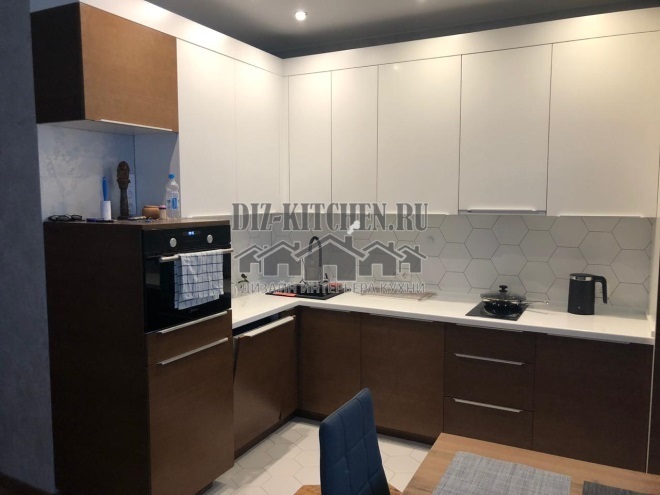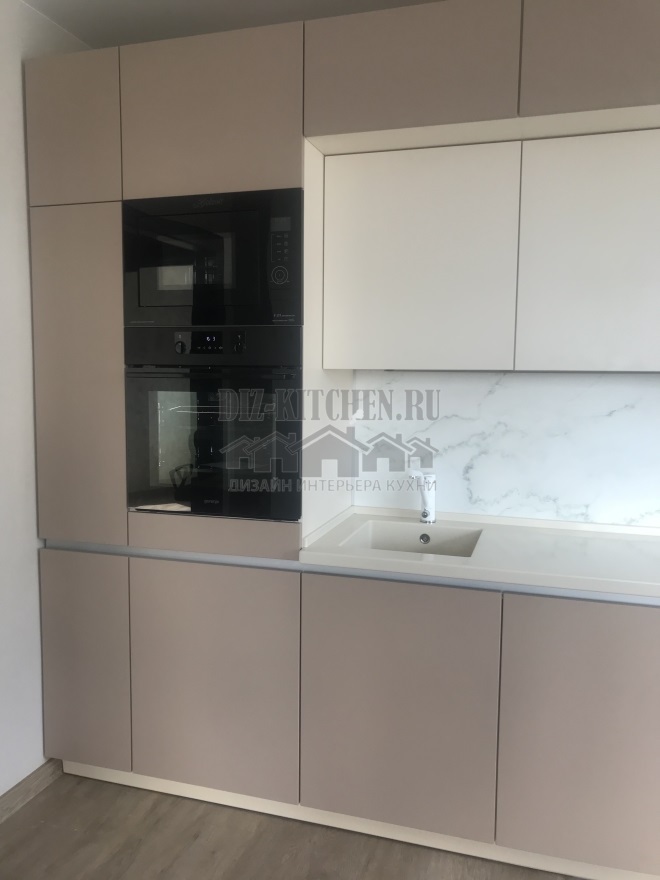It takes a lot of time and money to repair the ceiling, so many people decide to do the repair themselves. If you are one of them, then you need to know how to properly putty the ceiling. Without this "stage" it is impossible to carry out perfectly even painting, wallpapering the walls, and indeed any finishing method.
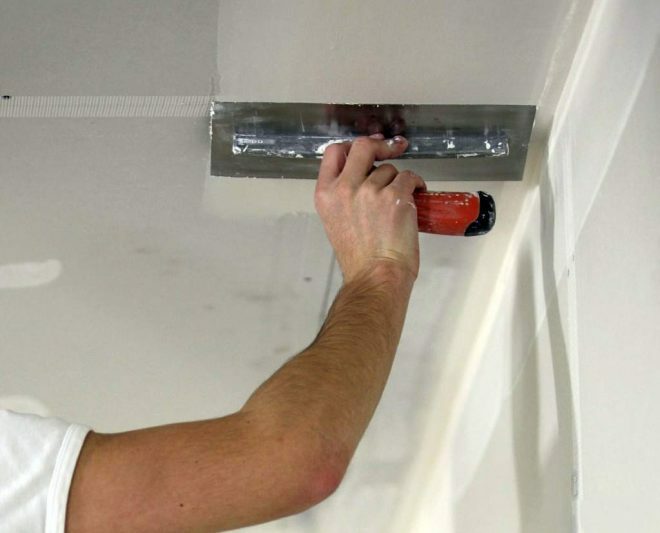
Required tools and materials
There are two types of putty. Both will be needed for puttying - starting and finishing.
Attention! Earned on our website kitchen designer. You can familiarize yourself with it and design your dream kitchen for free! May also come in handy wardrobes designer.
The starting putty is needed for the initial leveling of the surface. With its help, all deep cracks and seams are filled. Its structure is rather rough - there are many large "grains". But thanks to this structure, it is possible to quickly repair obvious defects.
The finishing putty is distinguished by its smallest fraction. It gives the surface the final smoothness.
It is very important to use products (primer, putties) from the same manufacturer and from the same range. It has the greatest compositional compatibility. At the same time, the quality of the result is noticeably higher than if products of different brands were used.
The set of tools depends on the type of selected filler. You can choose a dry composition that requires dilution in water or a ready-made mixture. The latter is much more convenient. There is no need to waste time mixing or rush for fear that the putty will harden. The finished solution retains its properties for a long time. But it will also cost more.
Dry putty is no worse than the finished one. The only drawback is the short life of the prepared mixture. She begins to harden, lose elasticity. Therefore, you do not need to knead the entire volume at once - dry putty is prepared in portions.
Tools that need to be prepared before starting work:
- An electric drill with a special nozzle for kneading putty or a construction mixer.
- Two vessels with vertical walls: the first for putty, the second for cleaning the nozzle, water is poured into it.
- Several spatulas: wide (50cm), medium for scooping up the mortar and transferring it to a wide spatula (11cm), narrow. You can do without a narrow one, but it may be needed if there are hard-to-reach areas in the room.
- Construction float with sanding mesh (or sandpaper). A sanding mesh or sandpaper is a must - the ceiling is always sanded after filling. Moreover, the initial layer is processed with coarse-grained sandpaper, and the last one is "zero".
- You will need a flute brush and a sponge for the skirting boards.
- Joinery trestles or stepladders.
- Great level.
- Spotlight for illumination.
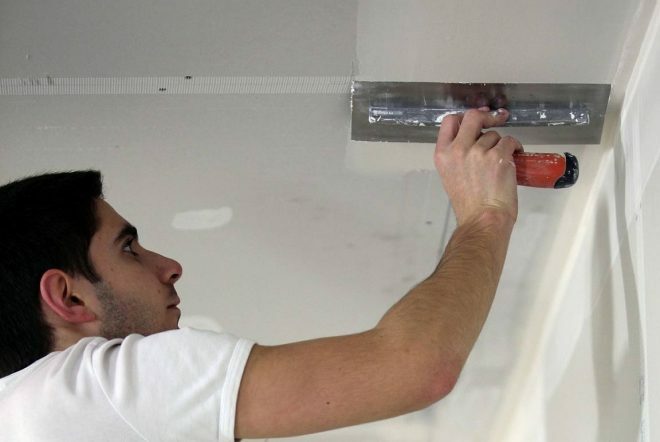
Preliminary preparation of the ceiling
The mixture should be applied to a clean and dry surface. Therefore, all finishing is removed from the ceiling, including the old layers of putty. You can simplify the task - moisten the ceiling with water and leave it for a while (no more than 20 minutes). The solution will absorb water during this time, and it will not be difficult to remove it. With a painted ceiling, the task becomes more difficult. You will need a hammer drill to handle the cleaning. If the paint was applied to the ceiling relatively recently, then it will be enough to sand the existing irregularities.
After we have removed the excess layers, you need to thoroughly clean the surface with a dry cloth and treat with a primer. Corners and joints must be primed especially carefully.
The priming step is very important. It helps not only to prevent the development of mold, but also improves the adhesion of the ceiling surface with the putty solution.
If there are gaps and cracks in the floors, they are sealed before priming.
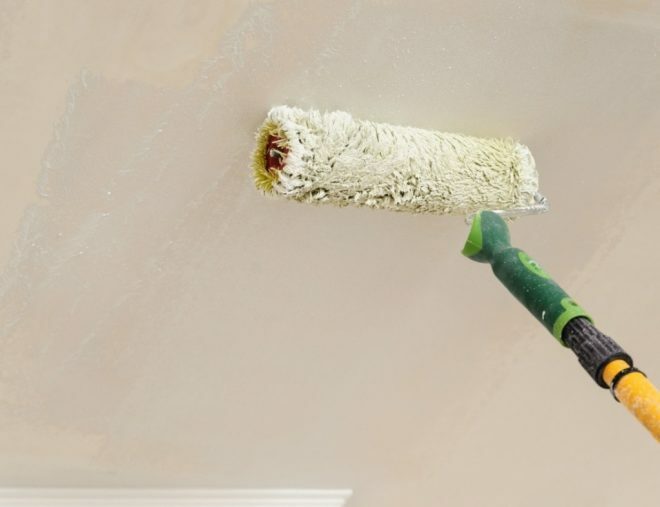
Stages of plastering the ceiling with your own hands
You can start puttingtying after all the necessary materials, tools have been purchased, and preparatory work has been done.
We knead the dry mixture
You need to take one of the containers and pour the dry putty mixture into it. You need to dilute with water at room temperature, add in small portions. The substance is stirred with a special nozzle with an electric drill or a construction mixer until the consistency of thick sour cream. It will be difficult to repair all defects with a liquid solution, and it also hardens for a long time. A very dense structure is also not welcome - there should be no lumps.
At the very beginning of the batch, you need to make slow turns. Gradually, the whisk of the nozzle should be lowered and the stirring zone expanded. When the mixture is more or less homogeneous, you can increase the number of revolutions. Then you need to stop kneading for a couple of minutes, then bring the mass to homogeneity. Keep in mind that if the speed of the drill is too high, a lot of unnecessary air will enter the solution. Air may cause bubbles to appear on the work surface.
If there is no special tool, you can also knead the putty manually with a spatula. Also, this method is suitable for starting application, since ideal smoothness is not so important there.
The life of the prepared mixture is 40 minutes. Never add water to an already hardened solution - the quality will get even worse, so it is wiser to prepare a new mixture. It is very important to wash the container from the remnants of the old putty.
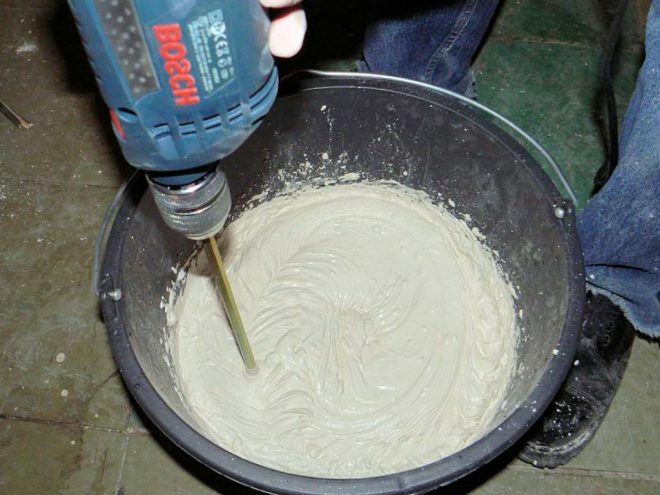
Putting putty on the ceiling
Consider the technology for applying the mixture to a concrete or plastered ceiling. Such a surface often has many defects. Starting putty will help to fix them.
- Using a medium spatula, close up large flaws. If the cracks are very large, then they need to be putty in several approaches, with each subsequent drying.
- All major defects are filled in and dried. Now we need to look at the level of the need for alignment on the horizontal plane. Severe differences require several coats.
- We collect the mixture with a medium spatula from the container and transfer it to a wide one with sliding movements.
- The hardest part is to apply the putty directly to the ceiling. If you've never done anything like this, it makes sense to practice on a different surface or ask someone more experienced.
- The spatula is applied to the junction of the ceiling and the wall and, with uniform pressure, is pulled along the ceiling until almost the entire composition remains on it.
- The remains are picked up with a medium spatula and the procedure is repeated.
- Stripes will remain on the ceiling, and you need to deal with them (level out) immediately. This is how the surplus is removed. The layer should not exceed a thickness of 3 mm.
- You need to wait for solidification. After that, the same is done only with the finishing putty, but the layer is made thinner.
Speaking about how to properly putty the ceiling, one cannot fail to mention sanding, which is the final stage of the process. This is where you need a spotlight. With it, you can see the smallest irregularities and sand them immediately.
If any defects are found at the end of all work, they should be eliminated point by point, without putting putty on the entire ceiling area.
Final finishing
By this we mean the filling of skirting boards. These decorative elements give the room a "completeness" look. But they do not always fit perfectly to the wall, most often gaps are formed.
Large gaps (2-3 mm) are removed with a starting putty, smaller ones - with a finishing one with a flute brush. It is very convenient to work with a brush when the skirting board has a complex relief profile.
The excess is removed with a sponge and the surface is gently sanded.
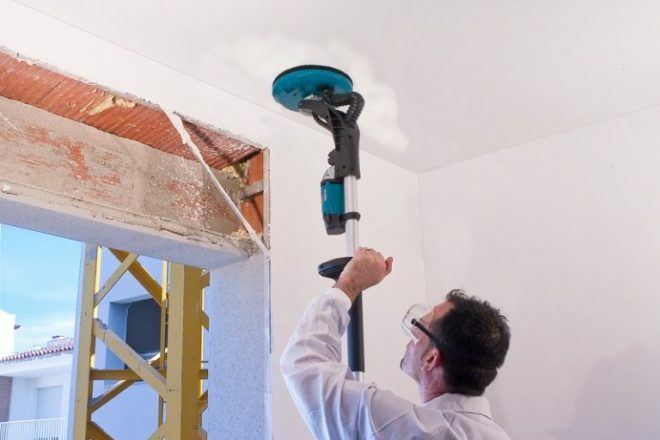
Features of plasterboard ceiling putty
Now let's figure it out how to putty the ceiling if it is made of drywall. It is worth noting that this is much easier to do, because the drywall itself is even. Moreover, the sheets themselves are leveled during their installation.
We use starter putty on plasterboard ceilings only for sealing joints and screw holes. It is very important to make sure that the tip of the screw does not protrude beyond the sheet.
You also need to prepare the joints. We need to deepen them, cutting off the edges at an angle of 45 degrees, and clean them of dust.
- We prime the ceiling, paying special attention to the seams.
- We fill the joints with starting solution, glue the serpyanka. It needs to be "drowned" in the putty with a spatula. Then the seam is putty and the surface is flattened.
- The removed seams and the places where the screws were attached are putty without reinforcing tape.
- When the putty is dry, you need to grind the seams and treat them with a primer.
- The last step is to apply a thin layer of the finishing mixture, grind the surface.
It is imperative to putty the ceiling, both concrete and plasterboard. In the second case, this will create an additional protective layer, which will help save on further repairs.
Tips & Tricks
If the ceiling was putty for painting, the finishing primer had to be chosen from a waterproof material. But do not be upset if you have already purchased the usual mixture. To make it waterproof we need to use a primer. It is added at the stage of kneading the putty, and is preliminarily diluted in water.
When painting the ceiling, it is not recommended to press on the roller and carry it over one place many times so as not to harm the putty layer.
The same waterproof primer will help prevent the putty from peeling off. Only you need to process it at the end, on top of the frozen composition.
Do not start repairing the ceiling in an apartment from the largest room if you have not previously done it. Better to practice in a small area, such as a bathroom or toilet. It is better to putty the ceiling of the living room or bedroom with a more "experienced" hand.
average rating 0 / 5. Number of ratings: 0
No ratings yet. Be the first to rate.

